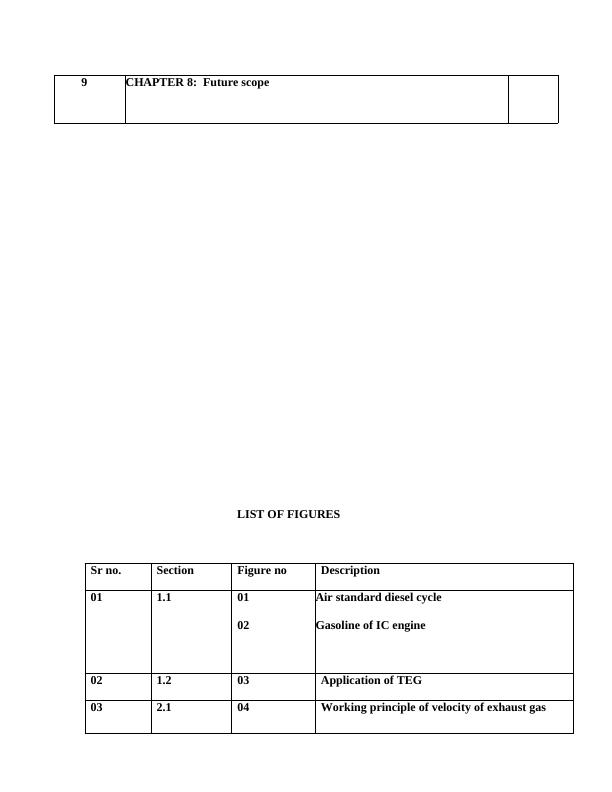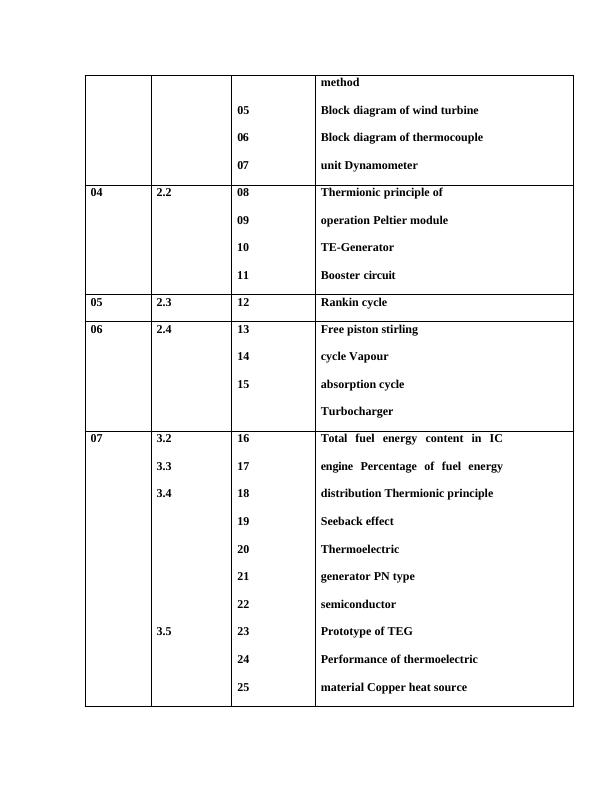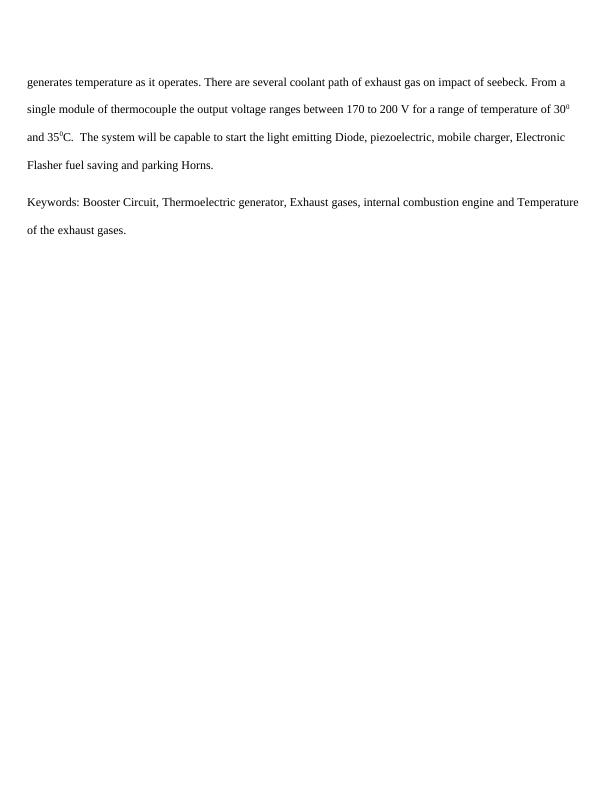Types of TEG Efficient Materials
69 Pages8656 Words27 Views
Added on 2022-09-07
Types of TEG Efficient Materials
Added on 2022-09-07
ShareRelated Documents
Name: Divyesh Gamechi
Student id no: P2416589
Module name: Dissertation
Topic Name: “Power generation using exhaust gases of Internal combustion engine”
Guided by: - Professor Rick Greenough
SR. NO. TITLE PAGE
NO.
1 ABSTRACT 2
2 CHAPTER 1: INTRODUCTION 3
Student id no: P2416589
Module name: Dissertation
Topic Name: “Power generation using exhaust gases of Internal combustion engine”
Guided by: - Professor Rick Greenough
SR. NO. TITLE PAGE
NO.
1 ABSTRACT 2
2 CHAPTER 1: INTRODUCTION 3

1.1 INTRODUCTION OF I.C. ENGINE
1.1.1 The Four Stroke Diesel Engine
1.1.2 Introduction of Gasoline of IC engine
1.1.3Exhaust gases recover
1.2 IMPORTANCE OF POWER GENERATION
1.2.1 ADVANTAGES
1.2.2APPLICATIONS
3 CHAPTER 2: DIFFERENTS METHODS OF POWER GENERATION
2.1 BY VELOCITY OF EXHAUST GASES
2.2 BY THERMOELECTRIC GENERATOR
2.2.2Description of the Equipment
2.3 BY RANKINE CYCLE
2.4 BY STIRLING CYCLE
4
4
Chapter 3
3.1 SELECTION OF METHOD OF POWER GENERATION
3.2 INTRODUCTION OF METHOD AND COMPONENTS
3.2.1 THERMOELECTRIC GENERATOR
3.3 Classified in two categories
3.4 P-N TYPE OF SEMICONDUCTORE
10
16
17
1.1.1 The Four Stroke Diesel Engine
1.1.2 Introduction of Gasoline of IC engine
1.1.3Exhaust gases recover
1.2 IMPORTANCE OF POWER GENERATION
1.2.1 ADVANTAGES
1.2.2APPLICATIONS
3 CHAPTER 2: DIFFERENTS METHODS OF POWER GENERATION
2.1 BY VELOCITY OF EXHAUST GASES
2.2 BY THERMOELECTRIC GENERATOR
2.2.2Description of the Equipment
2.3 BY RANKINE CYCLE
2.4 BY STIRLING CYCLE
4
4
Chapter 3
3.1 SELECTION OF METHOD OF POWER GENERATION
3.2 INTRODUCTION OF METHOD AND COMPONENTS
3.2.1 THERMOELECTRIC GENERATOR
3.3 Classified in two categories
3.4 P-N TYPE OF SEMICONDUCTORE
10
16
17

3.5 HEAT ABSORBUNT MATERIALS
3.6 PREDESIGN LEARNING (LNM)
5
CHAPTER 4: Design
4.1 Experimental setup
6
CHAPTER 5: Results
5.1 EXPERIMENTAL RESULTS
7
CHAPTER 6 :CONCLUSION
8
CHAPTER 7: REFERENCES
3.6 PREDESIGN LEARNING (LNM)
5
CHAPTER 4: Design
4.1 Experimental setup
6
CHAPTER 5: Results
5.1 EXPERIMENTAL RESULTS
7
CHAPTER 6 :CONCLUSION
8
CHAPTER 7: REFERENCES

9 CHAPTER 8: Future scope
LIST OF FIGURES
Sr no. Section Figure no Description
01 1.1 01
02
Air standard diesel cycle
Gasoline of IC engine
02 1.2 03 Application of TEG
03 2.1 04 Working principle of velocity of exhaust gas
LIST OF FIGURES
Sr no. Section Figure no Description
01 1.1 01
02
Air standard diesel cycle
Gasoline of IC engine
02 1.2 03 Application of TEG
03 2.1 04 Working principle of velocity of exhaust gas

05
06
07
method
Block diagram of wind turbine
Block diagram of thermocouple
unit Dynamometer
04 2.2 08
09
10
11
Thermionic principle of
operation Peltier module
TE-Generator
Booster circuit
05 2.3 12 Rankin cycle
06 2.4 13
14
15
Free piston stirling
cycle Vapour
absorption cycle
Turbocharger
07 3.2
3.3
3.4
3.5
16
17
18
19
20
21
22
23
24
25
Total fuel energy content in IC
engine Percentage of fuel energy
distribution Thermionic principle
Seeback effect
Thermoelectric
generator PN type
semiconductor
Prototype of TEG
Performance of thermoelectric
material Copper heat source
06
07
method
Block diagram of wind turbine
Block diagram of thermocouple
unit Dynamometer
04 2.2 08
09
10
11
Thermionic principle of
operation Peltier module
TE-Generator
Booster circuit
05 2.3 12 Rankin cycle
06 2.4 13
14
15
Free piston stirling
cycle Vapour
absorption cycle
Turbocharger
07 3.2
3.3
3.4
3.5
16
17
18
19
20
21
22
23
24
25
Total fuel energy content in IC
engine Percentage of fuel energy
distribution Thermionic principle
Seeback effect
Thermoelectric
generator PN type
semiconductor
Prototype of TEG
Performance of thermoelectric
material Copper heat source

26 Aluminium material heat
source Booster circuit
08 4.1 27
28
TEG setup (fabricated for present study)
Experimental setup for present
09 5.1 29
30
Time Vs temp difference
Temp difference Vs generated voltage
ABSTRACT
Currently, a perfect deal of the efforts of the mechanical firm is concentrated on advancement on the general
vehicle ́s efficacy. Each kind of engine operates as heat engine. This engine operates by converting chemical
energy to thermal energy and when the motion of the piston is done on the heat pressure which carries air. This is
the reason why when starting a vehicle about 30% to 40 % of the energy. The amount of energy left is wasted just
as energy employed in cooling component and exhaust gases thus the efficiency is low. In this research paper there
are several kinds of methods that is employed in energy recovery as well as conversion of energy to electrical
energy to improve the operational efficiency. This paper examines the application of thermal generator for
production of energy. The generator (thermoelectric) generates waste gases steam and small Direct Current which
source Booster circuit
08 4.1 27
28
TEG setup (fabricated for present study)
Experimental setup for present
09 5.1 29
30
Time Vs temp difference
Temp difference Vs generated voltage
ABSTRACT
Currently, a perfect deal of the efforts of the mechanical firm is concentrated on advancement on the general
vehicle ́s efficacy. Each kind of engine operates as heat engine. This engine operates by converting chemical
energy to thermal energy and when the motion of the piston is done on the heat pressure which carries air. This is
the reason why when starting a vehicle about 30% to 40 % of the energy. The amount of energy left is wasted just
as energy employed in cooling component and exhaust gases thus the efficiency is low. In this research paper there
are several kinds of methods that is employed in energy recovery as well as conversion of energy to electrical
energy to improve the operational efficiency. This paper examines the application of thermal generator for
production of energy. The generator (thermoelectric) generates waste gases steam and small Direct Current which

generates temperature as it operates. There are several coolant path of exhaust gas on impact of seebeck. From a
single module of thermocouple the output voltage ranges between 170 to 200 V for a range of temperature of 300
and 350C. The system will be capable to start the light emitting Diode, piezoelectric, mobile charger, Electronic
Flasher fuel saving and parking Horns.
Keywords: Booster Circuit, Thermoelectric generator, Exhaust gases, internal combustion engine and Temperature
of the exhaust gases.
single module of thermocouple the output voltage ranges between 170 to 200 V for a range of temperature of 300
and 350C. The system will be capable to start the light emitting Diode, piezoelectric, mobile charger, Electronic
Flasher fuel saving and parking Horns.
Keywords: Booster Circuit, Thermoelectric generator, Exhaust gases, internal combustion engine and Temperature
of the exhaust gases.

CHAPTER 1: INTRODUCTION
• Heat engine: This is a type of engine which operates through conversion to mechanical work output from
thermal energy. Example of this involve the engine of diesel, engine of petrol and steam engine.
• For the working principle of the thermal energy to the operating fluid of the heat engine, the classification of
the heat engine as a combustion engine (CE) and an IC engine
• For an IC engine, the combustion occurs in an engine ́s working fluid therefore the fluid is polluted
with the product being combusted.
- A good example of the internal combustion engine is petrol engine, in this engine the working
fluid is a combination of air and fuel.
• For an EC engine burning fuels (fossil) is employed as a working fluid, such systems do not have a
direct contact with a combustion materials.
- A good example of EC engine is a steam engine and steam is the working fluid.
Internal combustion engines may be classified as:
- Compression Ignition engine
- Spark Ignition engine
• Combustion engine CI): In this type of engine the combustion process commenced at a point where the
• Heat engine: This is a type of engine which operates through conversion to mechanical work output from
thermal energy. Example of this involve the engine of diesel, engine of petrol and steam engine.
• For the working principle of the thermal energy to the operating fluid of the heat engine, the classification of
the heat engine as a combustion engine (CE) and an IC engine
• For an IC engine, the combustion occurs in an engine ́s working fluid therefore the fluid is polluted
with the product being combusted.
- A good example of the internal combustion engine is petrol engine, in this engine the working
fluid is a combination of air and fuel.
• For an EC engine burning fuels (fossil) is employed as a working fluid, such systems do not have a
direct contact with a combustion materials.
- A good example of EC engine is a steam engine and steam is the working fluid.
Internal combustion engines may be classified as:
- Compression Ignition engine
- Spark Ignition engine
• Combustion engine CI): In this type of engine the combustion process commenced at a point where the

End of preview
Want to access all the pages? Upload your documents or become a member.
